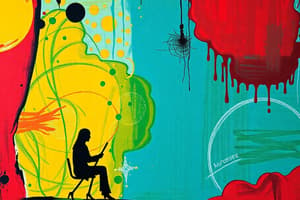Podcast
Questions and Answers
What does 'Contrast' refer to in dramatic elements?
What does 'Contrast' refer to in dramatic elements?
- A part of drama creating chaos
- Where things appear in discord to create change or interest (correct)
- Where things appear in harmony to create interest
- A technique used only in literature
What is 'Conflict' in drama?
What is 'Conflict' in drama?
An essential part of drama which creates chaos and disharmony in a play
What occurs at the 'Climax' of a performance?
What occurs at the 'Climax' of a performance?
The highest peak of a performance, usually happening at the end
What is a 'Symbol' in the context of drama?
What is a 'Symbol' in the context of drama?
What does 'Space' refer to in a performance?
What does 'Space' refer to in a performance?
How is 'Sound' utilized in drama?
How is 'Sound' utilized in drama?
What is the significance of 'Tension' in a performance?
What is the significance of 'Tension' in a performance?
What role does 'Timing' play in drama?
What role does 'Timing' play in drama?
What is 'Focus' in a dramatic performance?
What is 'Focus' in a dramatic performance?
What does 'Mood' represent in a performance?
What does 'Mood' represent in a performance?
Why is 'Language' important in drama?
Why is 'Language' important in drama?
What does 'Rhythm' refer to in a dramatic context?
What does 'Rhythm' refer to in a dramatic context?
Flashcards are hidden until you start studying
Study Notes
Dramatic Elements
-
Contrast: Utilizes opposing elements to evoke change or interest within the narrative. Enhances dynamics within the performance.
-
Conflict: A foundational element of drama, introducing chaos and discord that drives the plot forward and develops character relationships.
-
Climax: Represents the peak moment of tension and emotion in a performance, typically occurring towards the end.
-
Symbol: Employs objects or characters to convey deeper meanings, enriching the narrative by hinting at themes beyond the literal interpretation.
-
Space: Involves the strategic use of the stage to enhance storytelling, affecting how the audience perceives the action and relationships on stage.
-
Sound: Contributes to the overall atmosphere and emotional tone of a performance, generated by actors, rather than relying solely on technological effects.
-
Tension: Reflects the suspenseful buildup in a narrative; creates expectation for future developments, often linked to conflict and the lead-up to the climax.
-
Timing: Involves the rhythmic coordination of movements and gestures, playing a critical role in establishing pace and enhancing dramatic contrasts.
-
Focus: Central to a performer’s portrayal, requiring concentration and engagement to effectively deliver the character’s objectives and emotions.
-
Mood: Defines the emotional tone of the performance, shaped through stagecraft elements like lighting, movement, and actor interactions.
-
Language: Essential for storytelling, using both verbal and non-verbal communication techniques to convey the narrative and character intentions.
-
Rhythm: Characterizes the flow and tempo of the performance, incorporating patterns in actions and dialogue to create dramatic impact.
Studying That Suits You
Use AI to generate personalized quizzes and flashcards to suit your learning preferences.





